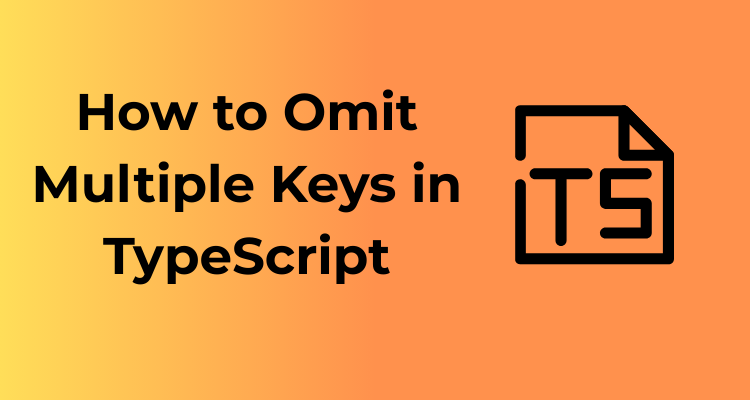TypeScript is an absolute game-changer when it comes to ensuring your code stays manageable, readable, and bug-free. One of its powerful features is the ability to handle object types with precision, especially when you need to omit certain keys. Speaking of which, what does “key omission” even mean? Let’s break it down in simple terms.
At its core, key omission is when you refine an existing object type by removing one or more of its keys (also referred to as properties). It’s like cherry-picking what parts of an object type you need, without redefining the whole thing from scratch. Sounds cool, right?
For example:
type User = {
id: number;
name: string;
email: string;
password: string;
};Now, let’s suppose you want to create a new type that includes all the properties of User, except for password. Instead of manually reconstructing the object type (and risking typos or inconsistencies), you can use utility types to remove that unwanted property. This process is what we call “key omission.”
Why Understand Key Omission?
Here’s the thing: when your project grows, so do your object types. If you find yourself redefining and duplicating types over and over just to exclude a key or two, you’re not only wasting time but also opening the door to inconsistencies. TypeScript’s omission tools ensure your types are both DRY (Don’t Repeat Yourself) and scalable. A win-win, right?
Key Terminology to Get Familiar With
Before diving deeper, let’s make sure you’re comfortable with some common terms we’ll toss around:
- Type: A blueprint for your data structure in TypeScript, defining what kind of value you expect.
- Utility Types: Built-in TypeScript features, like
Omit,Pick, andExclude, that simplify type manipulation. - Extending Types: Creating new types based on existing ones.
- Property Keys: The names of the fields in your object, like
id,name, orpassword.
The Role of Omit
Let’s shine a light on one of the superstar tools for key omission: Omit. This utility type allows us to specify which keys we want to exclude from a type. Think of it as selectively “hiding” properties while keeping the rest intact.
Here’s how you’d use it:
type PublicUser = Omit<User, 'password'>;
const user: PublicUser = {
id: 1,
name: "Alice",
email: "alice@example.com",
};
// Notice: No 'password' here!Easy, isn’t it? All we did was tell TypeScript, “Take the User type and remove the ‘password’ key from it.” The result is a new type, PublicUser, that you can now confidently use elsewhere in your code.
Why and When Would You Omit Multiple Keys?
Ever find yourself working with a complex object type in TypeScript and thinking, “I don’t need all of these keys!”? Well, you’re not alone. Knowing why and when to omit multiple keys is a powerful skill that can keep your code clean, organized, and efficient.
Why Omit Multiple Keys?
- To declutter your types: Imagine you’re working with an object that has ten or twenty keys, but you only care about half of them in a specific context. Including all those extra keys can make your code unnecessarily verbose and harder to understand.
- To improve type safety: Let’s say you want to ensure certain keys are “off-limits” in a particular use case. By omitting them, you can prevent accidental usage, reducing bugs and runtime issues.
- Custom tailoring for specific functions: Not every function needs full access to an object’s keys. Sometimes, simplifying the data structure to only what’s required can make that function clearer and easier to maintain.
- Enhanced reusability: Creating a version of a type with fewer keys can lead to more modular and reusable code. Think of it as creating mini, specialized building blocks instead of relying on a single, enormous piece.
When Should You Omit Multiple Keys?
Timing matters! Omitting keys isn’t something you should do arbitrarily. Here are some scenarios where omitting multiple keys makes total sense:
- When narrowing down data for a component: If a component only needs specific parts of an object, there’s no reason to pass or type in the entire object. Not only will it improve performance (as you avoid working with unnecessary data), but it also makes the component’s purpose crystal-clear.
- When strict contracts are required: Maybe you’re passing data to an external library or a third-party API that explicitly doesn’t accept specific keys. Omitting them guarantees compliance with their requirements.
- During code refactors: Over time, projects accumulate cruft. When you start tidying things up, reviewing existing types and making them leaner can play a big part in simplifying the whole codebase.
- For security and initialization: In some cases, sensitive keys (e.g.,
passwordorprivateKey) need to be stripped out when sending objects across boundaries, like to a frontend from a backend API. Omitting keys reduces the chance of accidentally exposing sensitive data.
Practical Advice: Strike a Balance
While omitting multiple keys can make your codebase neater and safer, the key (pun intended!) is to balance utility and complexity. Don’t go overboard creating a million tailored types for every corner of your application. Instead, ask yourself questions like:
- Does omitting these keys clarify my code’s intent?
- Will this omission help prevent errors, or does it introduce confusion?
- Is this simplified type reusable in other parts of my application?
If the answers fall in favor of your change, then go for it!
Tools in TypeScript for Key Manipulation
When working with TypeScript, you’ll eventually encounter situations where you need to tailor object types to better suit your needs. This often involves omitting, extracting, or modifying keys. But how do you efficiently handle such situations? TypeScript offers a robust suite of tools designed specifically for key manipulation. Let’s dive in!
The Power of TypeScript Utility Types
First, let’s talk about utility types—these are built-in gems that simplify manipulating types in TypeScript. For key manipulation, a few of these tools really shine. Here’s what you need to know about the most commonly used ones:
Pick: WithPick, you can create a new type by “picking” a set of specific keys from an existing type. Think of it as creating a pared-down version of a type where only the essentials remain.
Example: If you only want a type containing the “name” and “age” keys from an interface,Pickhas you covered.Omit: This one’s your go-to tool for removing specific keys from a type. Instead of explicitly defining which parts to retain, you specify the keys to exclude, and boom! A new, streamlined type.
Helpful Tip: CombineOmitwith interfaces for cleaner and more concise code when excluding multiple keys.Partial: Want to make all the properties of your type optional? That’s the job forPartial. It’s pretty handy if you’re dealing with objects that might have some optional properties when partially initialized.Exclude&Extract: These are a dynamic duo. They work great with union types!Excluderemoves elements from a union, whileExtractnarrows down the union to only include specified elements. Although they’re not directly related to key manipulation, they’re worth knowing, as you might use them in tandem with other types.
Customizing Key Behaviour with Index Signatures
While utility types are incredibly powerful, you might encounter scenarios where you need finer control over how keys behave. This is where index signatures come into play. Index signatures allow you to dynamically define how a type should handle keys while ensuring type safety.
For example: { [key: string]: number } tells TypeScript that any key of this object must be a string, and its corresponding value must be a number. Elegant, right?
True mastery of TypeScript comes when you can combine utility types with custom index signatures to create reusable, extensible types tailored to your projects.
Let’s Not Forget Conditional Types
Conditional types are another advanced tool for manipulating keys. Using the extends keyword, you can create types that adapt based on certain conditions. For instance, you could conditionally omit keys based on their value type or other criteria. It’s like giving your types a built-in “if-else” mechanism!
Example:
type FilterKeys<Base, Condition> = {
[Key in keyof Base]: Base[Key] extends Condition ? Key : never
}[keyof Base];
With a snippet like this, you can filter keys in a way that feels almost magical. It’s versatile and a fantastic addition to your TypeScript arsenal.
The Step-by-Step Guide to Exclude Multiple Keys
Alright, so you’ve dipped your toes into TypeScript and stumbled across the need to exclude multiple keys from an object type. Don’t worry, we’ve all been there! Whether you want to clean up your code, simplify your types, or focus only on the properties that matter, here’s a friendly, step-by-step guide to mastering this skill.
Step 1: Define Your Base Type
Before you can start excluding keys, you need to define the original type you’ll be working with. Let’s say we have a type called Person:
type Person = {
name: string;
age: number;
email: string;
address: string;
};
Think of this as the blueprint or template for an object. It contains all the properties that a Person can have.
Step 2: Use the Omit Utility Type
This is where the magic begins! TypeScript provides a built-in utility type called Omit to help you remove keys from an existing type. To exclude multiple keys, simply pass the type and the keys you want to exclude. Here’s how:
type SimplifiedPerson = Omit<Person, "email" | "address">;
Here’s what’s happening:
Omitis the star of the show—it tells TypeScript to create a new type based on your original type but without the specified keys.- The first argument is your base type,
Person. - The second argument is a union of the keys you want to omit—notice how we used the vertical bar
|to combine"email"and"address".
Now, SimplifiedPerson only contains the name and age properties. Easy peasy, right?
Step 3: Double-Check Your Result
Let’s put our new type to the test. You can use it to type an object like this:
const person: SimplifiedPerson = {
name: "Alice",
age: 30
};
If you try to add email or address to this object, TypeScript will throw an error. That’s how you know you’ve successfully excluded those keys!
Step 4: Scaling Up
What if you’re working with a larger type that has a bunch of keys to omit? Typing out the union manually can be tedious. In such cases, you can define a helper type:
type OmittedKeys = "email" | "address"; type SimplifiedPerson = Omit<Person, OmittedKeys>;
By grouping the keys into a separate type, your code becomes more organized and easier to update in the future. Plus, it’s much more readable!
Real-World Example: Simplify Object Types Efficiently
Have you ever found yourself staring at a TypeScript object, feeling overwhelmed by the sheer number of properties in a type? Trust me, you’re not alone! Sometimes, all we want is to clean things up and focus only on specific parts of an object. Let’s work through a real-world example that showcases how to efficiently simplify object types by omitting multiple keys.
The Scenario
Imagine you’re building a User Management System. Your `User` type might look something like this:
type User = {
id: number;
name: string;
email: string;
password: string;
role: string;
createdAt: Date;
};
Now, suppose you’re creating a public profile, and you don’t want to expose sensitive fields like password, email, or administrative data like createdAt. How do you simplify this structure to keep only the relevant properties visible?
Using TypeScript to Omit Keys
Here’s where TypeScript swoops in like a superhero. You can use the built-in Omit utility type to specify the fields you want excluded. For multiple keys, it’s as simple as listing them in a union.
type PublicUser = Omit<User, 'password' | 'email' | 'createdAt'>;
Just like that, we’ve created a cleaner, safer, and more focused type:
type PublicUser = {
id: number;
name: string;
role: string;
};
Why This Example Matters
The beauty of this approach is in its simplicity and readability. By using Omit, the intention behind your code is crystal clear: you only want specific fields excluded, and you’re doing this directly at the type level. No complex transformations or manual filtering required!
A Practical Application
Let’s extend the public user example a bit. Maybe you’re sending this data to a frontend app for displaying user profiles. With the cleaned-up PublicUser type, you reduce the risk of inadvertently exposing sensitive fields. Here’s an example of this in action:
function getPublicUser(user: User): PublicUser {
return {
id: user.id,
name: user.name,
role: user.role,
};
}
// Example usage:
const user: User = {
id: 1,
name: 'Jane Doe',
email: 'jane.doe@example.com',
password: 'supersecretpassword',
role: 'admin',
createdAt: new Date(),
};
const publicUser = getPublicUser(user);
console.log(publicUser);
// Output: { id: 1, name: 'Jane Doe', role: 'admin' }
What Makes This So Efficient?
- Readability: Your colleagues (and future you!) will appreciate type definitions that clearly state the excluded keys.
- Reusability: The
PublicUsertype can now be used consistently across your project wherever sensitive data shouldn’t be included. - Error Reduction: Mistakes like including sensitive data in responses become much harder due to the clean type separation.
Combining Utility Types to Simplify Coding
Hey there, fellow TypeScript enthusiast! Let’s dive into one of the coolest parts of working with TypeScript: combining utility types to make our lives as developers easier and our code sleeker. If you’ve ever wondered how to save yourself time while writing clean and maintainable TypeScript code, you’re in the right place.
Why Combine Utility Types?
Think of utility types as the trusty tools in your developer toolbox. They’re powerful on their own, but when combined, they become game-changers! By merging them strategically, you can handle more complex scenarios without having to reinvent the wheel (or object, in our case).
For instance, what if you wanted to create a type that omits some keys from an object and makes the rest optional? Or perhaps you want to create a read-only version while excluding certain properties. By combining utility types, you can achieve all this and more, while keeping your code concise and understandable.
The Magic Formula: Building on Built-ins
TypeScript comes bundled with some amazing utility types, like Omit, Pick, Partial, and Readonly. Combining them effectively can help you manipulate object types in efficient and innovative ways. Let’s look at an example.
A Handy Example
Imagine you’re working on a User type like this:
export interface User {
id: number;
name: string;
email: string;
password: string;
}
Now, say you need a type where we:
- Omit
password(for security reasons). - Make
emailoptional (to allow for partial updates).
Instead of creating this type manually, let’s combine Omit and Partial:
export type SafeUser = Partial<Omit<User, 'password'>>;
Voilà! This type excludes the password key and makes all the remaining properties optional. How cool is that?
Supercharging Utility Types
Sometimes, you may want even more customized combinations. Here’s an example of nesting and building utility types dynamically:
type RequiredThenReadonly<T, K extends keyof T> = Readonly<Required<Pick<T, K>>> & Omit<T, K>;
This utility type will let you select specific fields to make both required and readonly, while keeping the rest of the properties untouched. Don’t underestimate the power you have to create flexible abstractions to suit unique project needs!
Best Practices for Combining Utility Types
While experimenting with utility types, it’s important to keep a few tips in mind:
- Keep It Readable: Over-combining can make types hard to read. Use descriptive type names and comments for clarity.
- Test Your Types: Use TypeScript’s type inference to ensure your custom types behave as expected. A quick hover-over in your IDE can reveal a lot.
- Think Reusability: If you find yourself combining the same utility types often, extract it into a reusable type alias like
SafeUser. - Simplify Complex Logic: Break down overly complex types into smaller composable ones.
When Not to Combine Types
There’s such a thing as too much abstraction. If your combined types are becoming overly complex and hard to debug, it might be better to stick with straightforward approaches or split the logic into smaller, manageable components.
Common Errors and How to Avoid Them
TypeScript is a fantastic tool that developers love for its ability to add type-safety and make JavaScript code more robust. However, when working with advanced features like omitting multiple keys, things can get tricky. Let’s dive into some of the most common errors developers encounter and learn how to tackle them like a pro!
1. Forgetting to Use Correct Utility Types
One of the most common pitfalls is forgetting to use Omit or combining it properly when working with TypeScript. For instance, you might rely on manual object manipulation, such as deleting properties, rather than leveraging TypeScript’s built-in utility types. Yes, it’s tempting to just wing it—but trust me, it’s a recipe for inconsistency and bugs!
How to avoid it:
- Learn and leverage utility types like
Pick,Omit, andExclude. - Refer to the TypeScript docs whenever you’re unsure about which utility type to use.
- Experiment with small, testable examples to see how these utility types behave.
2. Key Misalignment
A classic error involves misspelling keys or omitting keys that don’t actually exist in your interface or type. For example, if you try to omit "adres" instead of "address", TypeScript won’t catch it as an error—it simply won’t omit anything, leading to silent frustration.
How to avoid it:
- Use editors like Visual Studio Code that provide auto-suggestions for keys and variables. This feature minimizes typos.
- Double-check the key names in the interface or object type definitions before omitting them.
3. Using Omit on Non-Object Types
This one’s sneaky! Omit is specifically designed for object types. If you accidentally apply it to anything other than objects (like arrays or primitive types), TypeScript will throw a type error.
How to avoid it:
- Ensure you are working with object types before using
Omit. - Use TypeScript’s
typeofor type inference techniques to confirm the type beforehand.
4. Nested Structures Causing Confusion
Here’s a tricky one: omitting keys only works on the current level of an object type. If you’re trying to omit keys inside a nested structure, using Omit as-is won’t cut it. For example:
type NestedExample = {
levelOne: {
keyA: string;
keyB: number;
};
}
type Result = Omit<NestedExample, "keyA">; // Won't affect "keyA" inside "levelOne."
How to avoid it:
- If you’re dealing with nested objects, you’ll need to use more advanced techniques or define custom utility types to omit keys from nested levels.
- Consider libraries or tools designed to simplify deeply nested type manipulation, such as ts-toolbelt.
5. Not Accounting for Optional Properties
When interfaces and types include optional properties (indicated by ?), omitting them can have unexpected results. Sometimes, you might forget that optional properties will still linger unless explicitly excluded.
How to avoid it:
- Review object structures thoroughly for optional properties that might need to be omitted.
- Be extra cautious with tools like
Partialthat can introduce optional properties into your types.









